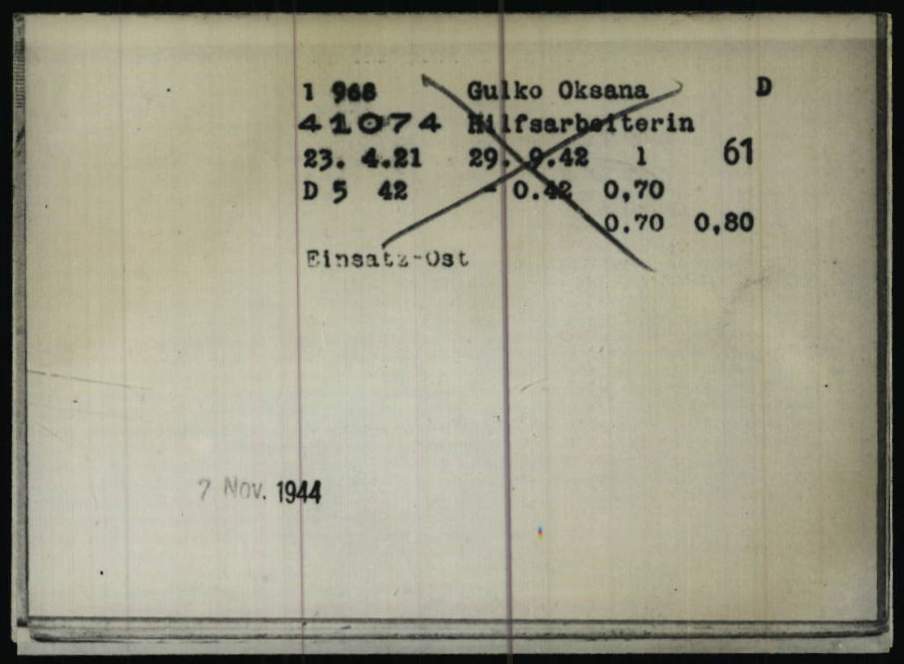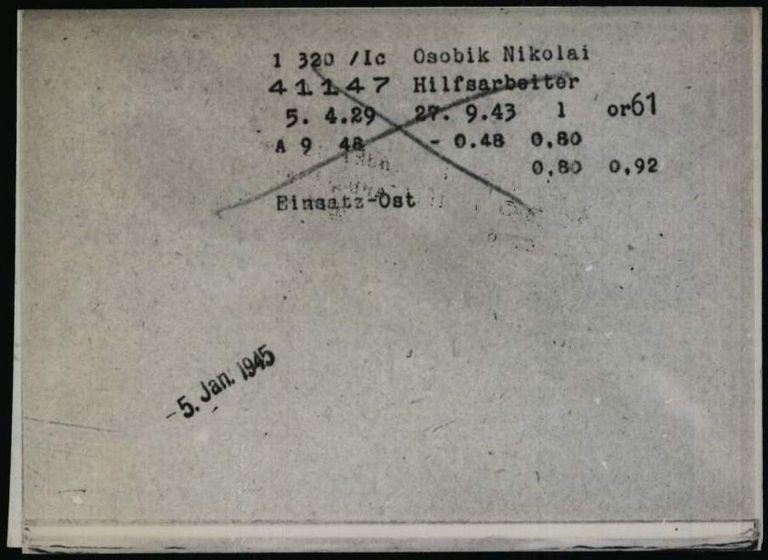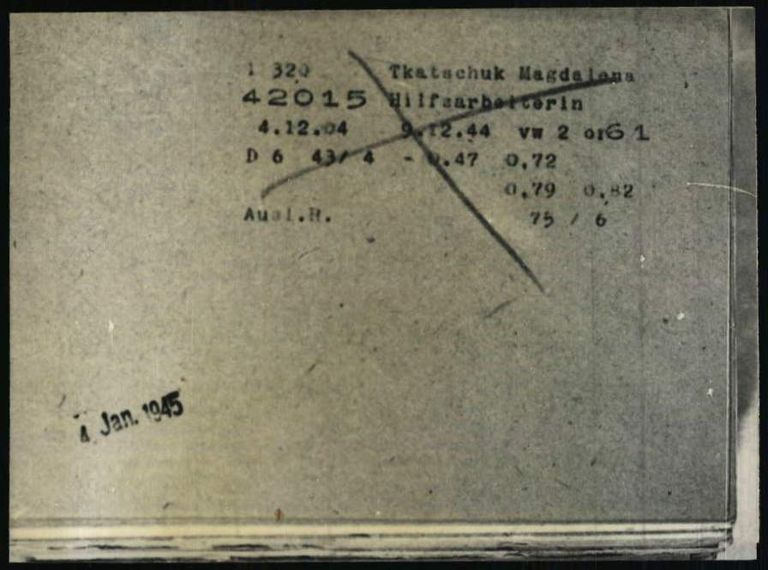Page of
Page/
- Reference
- Intro


So-called Messerschmitt cards are part of a card file used to manage concentration camp prisoners and civilian laborers who were required to perform forced labor at the Messerschmitt factories in Bavaria. The cards of civilian forced laborers can be recognized by the fact that the information they contain has almost always been crossed out. The backs of cards that were no longer needed were used for details of concentration camp prisoners. Information on western and eastern European civilian laborers has therefore only been preserved by chance.
So-called Messerschmitt cards are part of a card file used to manage concentration camp prisoners and civilian laborers who were required to perform forced labor at the Messerschmitt factories in Bavaria. The cards of civilian forced laborers can be recognized by the fact that the information they contain has almost always been crossed out. The backs of cards that were no longer needed were used for details of concentration camp prisoners. Information on western and eastern European civilian laborers has therefore only been preserved by chance.
Questions and answers
-
Where was the document used and who created it?
Employees in the personnel department of the Messerschmitt company in Augsburg created index cards for the civilian forced laborers who were employed in Augsburg and Leonberg.
- When was the document used?
The cards show the details of civilian forced laborers who were employed at Messerschmitt AG between 1942 and 1945. Cards of concentration camp prisoners who were employed at Messerschmitt in the last two years of the war, 1944 and 1945, have also been preserved. The personnel card file had obviously already been created in the period before the war, as there are also cards relating to German civilian employees who worked for Messerschmitt in the 1930s or for Bayerische Flugzeugwerke (BFW), as the company was called prior to 1938.
In April 1974, Messerschmitt-Bölkow-Blohm GmbH gave its card file from the 1940s to the International Tracing Service (ITS), the predecessor institution of the Arolsen Archives. The ITS made microfilms of the cards, which can now also be searched online. The original cards are also in the Arolsen Archives.
- What was the document used for?
Like all large German armaments companies, Messerschmitt AG employed civilian forced laborers. In Augsburg, where the company had its headquarters, they were housed separately from the concentration camp prisoners who were also deployed there from April 1944. The proportion of forced laborers increased over the course of the war. As far as the production facility in Regensburg is concerned, it is known that in April 1945, around 6,350 workers, i.e. almost half of the workers employed there, were foreign forced laborers. They worked on the construction of fighter planes, which was considered a job that was essential for the war effort.
For administrative purposes, the personnel department at Messerschmitt created index cards for their entire workforce, which included German civilians, civilian forced laborers, and concentration camp prisoners. Since there were different regulations for remunerating the work of these groups, their cards were different. Unfortunately, the significance of most of the information is unclear today. However, various duties and charges had to be paid for civilian forced laborers, and presumably these are noted on the index cards created by the personnel department. The information may include the following: hourly wage paid, amounts retained for board and lodging, deductions for Deutsche Arbeitsfront (DAF) fees, income tax, or social insurance.
The cards were produced using ADREMA machines (short for addressing machines). This system, which was used very widely in Germany at the time, involved stamping various individual pieces of information about a person into metal plates. When the plates were inserted into the machine, the operator could decide which information should be printed.
- How common is the document?
The Arolsen Archives hold 4,607 so-called Messerschmitt cards. However, most of these cards have writing on both sides. This means that the 4,607 cards contain information about almost twice as many people. How many were produced for concentration camp prisoners, and how many for civilian forced laborers is not yet clear. However, by no means all of the cards for the civilian forced laborers employed at Messerschmitt have been preserved.
- What should be considered when working with the document?
The cards show the unequal treatment of civilian forced laborers based on their nationality and gender. The duties and charges that were noted on the right-hand side of the card are always lower for Soviet women than for men, indicating that their basic wage was lower. The different treatment received by concentration camp prisoners, who were required to work without pay, also becomes clear when a comparison is made between cards.
In the Arolsen Archives, the Messerschmitt cards are not stored in the collection of documents on forced labor, but in the Dachau concentration camp collection (1.1.6.8). The reason for this is that Dachau prisoners are mentioned on the back of the cards.
Initially, the Messerschmitt company recruited volunteers mainly from western Europe and Italy. Prisoners of war were also used in production. Unfortunately, it is not yet known how their cards differ from those of civilian forced laborers.
If you have any additional information about this document or any other documents described in the e-Guide, please send your feedback to eguide@arolsen-archives.org. The document descriptions are updated regularly – and the best way for us to do this is by incorporating the knowledge you share with us.
Help for documents
About the scan of this document <br> Markings on scan <br> Questions and answers about the document <br> More sample cards <br> Variants of the document


